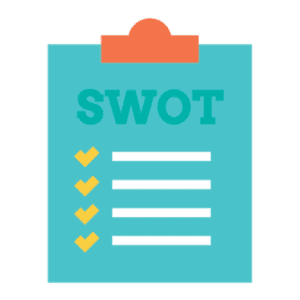On this page:
- What is a Strategic Plan?
- Strategic Plan vs Business Plan
- What are the Key Elements of a Strategic Plan?
- How to Write Each Section of Your Strategic Plan
- How to Measure the Success of Your Strategic Plan
- Conclusion
- Other Helpful Business Plan Articles & Templates
Over the past 20+ years, Growthink has developed strategic plans for thousands of companies, small business owners, and entrepreneurs. Many of them have gone on to reach incredible success. Below you will find our thinking on the strategic planning process, how to measure progress, and how to create a great plan for your company.
What is a Strategic Plan?
A strategic plan is a process, most often undertaken by organizations, governments, and businesses to define the organization’s strategy. In simple terms, strategy is a course of action or thought-out method used in achieving an objective or set of objectives. It may also be referred to as a strategic document or strategic outlook.
This type of plan includes the organization’s mission and vision – describing where it is going – as well as its core values, concepts, strategies for achieving the objectives, and plans for evaluating progress towards those objectives. It may also include a supporting action plan that prioritizes critical tasks needed to implement the strategy successfully.
In most cases, strategic planning is a continuous process that helps an organization be successful now and beyond. Planning isn’t just about deciding what to do—it’s also about identifying what not to do so resources can be focused on implementing high-priority initiatives. Consider strategic planning a toolbox full of options from which you select the right tools for your job at hand.
Strategic Plan vs Business Plan
The components of a strategic plan include goals, strategic initiatives (the ways in which you’re going to pursue your goals), and action plans (a list of the specific activities that support each strategic initiative). A business plan typically includes some or all of these components but there are important differences between strategic planning and business planning.
Both types of plans can be created for established businesses as well as any new business ventures.
One way to think about it is that strategic plans address the entire year, providing “big picture” thinking while business plans focus more on the details of day-to-day operations.
Strategic planning also tends to look 3–5 years ahead whereas a small business might find it difficult to forecast that far into the future.
Strategic plans typically look at things like management structure, company growth, strategic alliances or mergers, and strategic positioning in the market.
A strategic plan template is useful for organizations contemplating major changes while a small business owner can use strategic planning techniques when making decisions around which new strategic initiatives to pursue.
Business plans are written to present a realistic assessment and roadmap of how well your company could perform within 3–5 years when you take into account factors such as the market demand for your product or service, how much it will cost to produce your product or provide your service, how much it costs to acquire customers, potential risks in starting up your small business, where you will get money if needed and what would need to happen for this plan to become reality.
A business plan is written with the intention of letting outsiders, such as banks or angel investors, see how well your business could perform financially within 3–5 years.
Both types of planning are well worth your time and effort to ensure the prosperity of your business.
Finish Your Strategic Plan Today!
If you’d like to quickly and easily complete your strategic plan, download Growthink’s Ultimate Strategic Plan Template and complete your plan and financial model in hours.
What are the Key Elements of a Strategic Plan?
Organizations undertake strategic planning to define their priorities and align their team in pursuit of those priorities. Strategic planning is a crucial tool that can refocus a business’ energies to where they will be best spent.
In spite of the great importance and scope, many times it is ignored or quickly completed each year with no strategic focus. Or it is created, but results are not measured against it. The end result is neither strategic nor even a plan.
Successful companies, on the other hand, have and continue to make use of strategic planning to consistently stay on top of their game. You can too. Below, we offer a comprehensive strategic plan template and examples that can easily be used to initiate and establish effective strategic planning in your organization. The template discusses the 13 elements you must include in more detail below:
- Executive Summary
- Elevator Pitch
- Mission Statement
- SWOT Analysis
- Goals
- Key Performance Indicators (KPIs)
- Target Market Analysis
- Industry Analysis
- Competitor Analysis
- Marketing Plan
- Human Resources Plan
- Operations Plan
- Financial Projections
How to Write Each Section of Your Strategic Plan
Executive Summary

Including a summary is important because it allows you to quickly and effectively present your plan to key stakeholders. It is crucial that you are able to disseminate the plan throughout your organization as its success hinges on everybody’s buy-in and support.
Elevator Pitch

Since an elevator pitch is a short yet striking description of your company, it also helps motivate employees causing them to work hard and take pride in their organization. Such fostering of a positive culture will attract impassioned people to your organization as well. For example, Microsoft in its founding days worked with the following pitch:
“A computer on every desk and in every home.”
Such inspirational statements are the direct result of strategic planning efforts and have wide-ranging benefits for a business.
Mission Statement

“Phillips’ mission is to improve people’s lives through meaningful innovation.”
Your plan should include a similarly inspirational mission statement so that business efforts are geared towards that one end goal.
SWOT Analysis

To create a plan that is truly strategic you need to spend a good amount of time conducting a SWOT analysis and thinking deeply about each of its individual elements.
Goals

Depending on your objectives you can even narrow your company’s goals down to quarterly, monthly, or even weekly goals. Clearly laying out a business’ goals ensures that people expend their energies towards things that actually matter.
While creating goals keep the following things in mind:
Do Not Go Very Broad
Avoid goals that are sweeping. For example, business objectives like ‘being successful’ or ‘being profitable’ are too broad to be useful. This can instead be reframed as “increasing sales by 20% in the next quarter” for instance. Strategize for goals that are easy to understand and act upon. This will also make it easy to evaluate performances later on and find out how well or poorly the business did. Effective goals are goals that can be measured. Strive for these.
Be Realistic
While setting goals it is easy to get carried away. Setting overly ambitious or practically unattainable goals will cause a significant drop in organizational morale as people get frustrated or even burnt out in pursuing such goals. Instead, set goals that are ambitious but within grasp.
Set Time-Bound Goals
Your plan must include goals with realistic deadlines. Time-specific goals allow employees to plan their amazing work more effectively, making it more likely that the goals will be met.
Key Performance Indicators (KPIs)

Figure out what the business needs from every stakeholder in order to improve performance and create separate KPIs accordingly. For example, KPIs for the marketing department will be different from those set for the human resources department and so on.
Finish Your Strategic Plan Today!
If you’d like to quickly and easily complete your strategic plan, download Growthink’s Ultimate Strategic Plan Template and complete your plan and financial model in hours.
Target Market Analysis

Your plan is worthless if it tries to win over every customer segment in your target market. It will most probably end up attracting none. Instead, a strategic plan must pinpoint the target customers whose conversion and retention will provide the business with the highest return on its expenditures.
Industry Analysis

You should discuss the market size and key trends, including if it is declining or growing. You must also identify your current position and desired position in the marketplace.
Competitor Analysis

Competitor analysis coupled with a broad industry analysis also forces you to think about other organizations that might turn into your competitors if industry trends change or markets mutate.
Most importantly, in this section figure out the best positioning of your company in the competitive mix. Importantly, figure out your current competitive strengths that you can exploit, or competitive strengths you need to gain in the coming period and how you will go about achieving them.
Marketing Plan

Human Resources Plan

If you feel you need to hire more employees or people with certain specific competencies then this is the place where you and your team should deliberate and document your human resources requirements. For instance, if your strategic plan includes diversifying into a new space, then it would be pertinent to start creating detailed job descriptions and interviewing people to execute this initiative. This way you will not impede your diversification plans due to a hiring crunch or having the wrong team trying to execute critical tasks.
Operations Plan

Here you must narrow down the overarching strategic aim of the business into smaller tactical goals to be executed by specific departments and/or teams. In this section, you will detail each of these goals along with the action plan for achieving them. We suggest using Gantt charts to map out the way your departments will attain key goals over time.
Financial Projections

Creating financial forecasts allows you to estimate the potential results of different strategies and analyze which might have the best impact on your business. Even when they are based on estimates, projections are able to reflect business realities pretty accurately provided your assumptions are realistic.
Importantly, use your projections as KPIs to judge your performance as you execute your strategic plan.
How to Measure the Success of Your Strategic Plan
Strategic plans can help you achieve financial and strategic goals over the short-term, mid-term, and long-term. The more specific your strategic goals are, the more likely they are to be achieved. So it’s important to set clear targets for each strategy in your plan and measure your progress over time. Some of the key metrics to track include:
Operational Metrics
These indicators measure how effectively a strategic goal is being executed on an ongoing basis. These types of metrics can be applied at both the business level (e.g., what percentage of orders are filled within 24 hours) or at the corporate level (how much inventory is carried per square foot).
Financial Metrics
Focusing on milestones in terms of achieving financial targets allows strategic goals to be quantified and measured. Some of the most common financial indicators applied within strategic plans include sales volume, sales growth rate, market share, number of new products launched, operating margins, and return on invested capital.
Impact Metrics
Finally, strategic plan metrics should inform how strategic investments will enable an organization to achieve its future business vision. A business vision is typically expressed as an aspirational strategic statement that captures where you want to go (i.e., your strategic direction) over the next five to ten years. Impact metrics can help evaluate if potential strategic investments are likely to deliver on that goal or not.
Conclusion
Establish a clear path and put your company in the right direction by including each of the elements outlined in the strategic planning sample above. Then, at the end of each month review your actual performance against your goals and projections in your plan. If you are on target, continue as planned. If not, consider adjusting your strategy or your plan. Business owners who constantly monitor their performance and adjust their plans reach their milestones and achieve the long-term success they desire.
Finish Your Strategic Plan in 1 Day!
Don’t you wish there was a faster, easier way to finish your strategic plan?
With Growthink’s Ultimate Strategic Plan Template you can finish your plan in just 8 hours or less!
Click here to get your strategy business plan template today.








